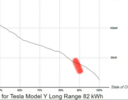From my POV, a software limited NCA pack and an LFP (w/o software lock) offer many of the same advantages. I think I’d be happy with either. The only scenario I wouldn’t like the current RWD is a smaller NCA pack.
I'm actually happier to have this software limited NCA pack than the LFP because you have decent charge speed right up to 100% making the capacity usable on longer trips. And I have a feeling a NCA pack that is never charged past 80% will have comparable life to an LFP that is regularly charged to 100%. If one goes with the recommended 80% charge (for a physical 64% charge) the degradation of the battery should be extremely low.
Id love to see a full charge curve, or at least a test of peaking charging speeds from 10-20%. If it can hit 250kw that’s also very strong evidence it’s a big pack (although I guess they may limit charging speed artificially as well)
The specs of the RWD show the peak charge speed at 170kw. However, this is probably software limited by the handshake between the car and the charger. I guess confirmation of this would be if there was a flat charge rate of 170kw from 0% to whatever charge state the regular LR pack reduces down to that speed. It'll be a while before I am able to test this as I don't drive a whole lot and it'll take some time to run down the battery.



